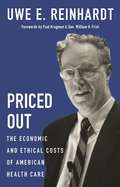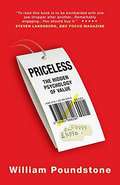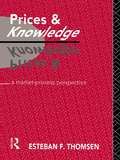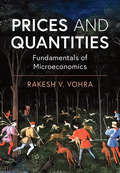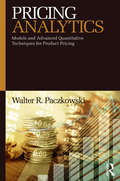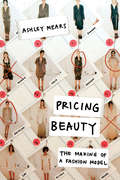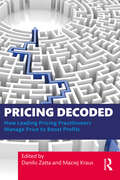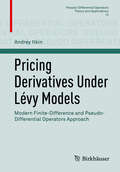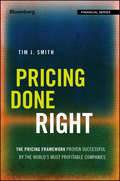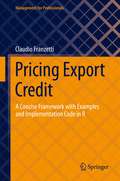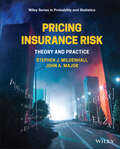- Table View
- List View
Priced Out: The Economic and Ethical Costs of American Health Care
by Uwe E. ReinhardtFrom a giant of health care policy, an engaging and enlightening account of why American health care is so expensive—and why it doesn't have to beUwe Reinhardt was a towering figure and moral conscience of health care policy in the United States and beyond. Famously bipartisan, he advised presidents and Congress on health reform and originated central features of the Affordable Care Act. In Priced Out, Reinhardt offers an engaging and enlightening account of today's U.S. health care system, explaining why it costs so much more and delivers so much less than the systems of every other advanced country, why this situation is morally indefensible, and how we might improve it.The problem, Reinhardt says, is not one of economics but of social ethics. There is no American political consensus on a fundamental question other countries settled long ago: to what extent should we be our brothers' and sisters' keepers when it comes to health care? Drawing on the best evidence, he guides readers through the chaotic, secretive, and inefficient way America finances health care, and he offers a penetrating ethical analysis of recent reform proposals. At this point, he argues, the United States appears to have three stark choices: the government can make the rich help pay for the health care of the poor, ration care by income, or control costs. Reinhardt proposes an alternative path: that by age 26 all Americans must choose either to join an insurance arrangement with community-rated premiums, or take a chance on being uninsured or relying on a health insurance market that charges premiums based on health status.An incisive look at the American health care system, Priced Out dispels the confusion, ignorance, myths, and misinformation that hinder effective reform.
Priceless: Curing the Healthcare Crisis
by John C. GoodmanIn this long-awaited updated edition of his groundbreaking work Priceless: Curing the Healthcare Crisis, renowned healthcare economist John Goodman ("father" of Health Savings Accounts) analyzes America&’s ongoing healthcare fiasco—including, for this edition, the failed promises of Obamacare.Goodman then provides what many critics of our healthcare system neglect: solutions. And not a moment too soon. Americans are entangled in a system with perverse incentives that raise costs, reduce quality, and make care less accessible. It&’s not just patients that need liberation from this labyrinth of confusion—it&’s doctors, businessmen, and institutions as well. Read this new work and discover: why no one sees a real price for anything: no patient, no doctor, no employer, no employee; how Obamacare&’s perverse incentives cause insurance companies to seek to attract the healthy and avoid the sick; why having a preexisting condition is actually WORSE under Obamacare than it was before—despite rosy political promises to the contrary; why emergency-room traffic and long waits for care have actually increased under Obamacare; how Medicaid expansion spends new money insuring healthy, single adults, while doing nothing for the developmentally disabled who languish on waiting lists and children who aren&’t getting the pediatric care they need; how the market for medical care COULD be as efficient and consumer-friendly as the market for cell phone repair... and what it would take to make that happen; how to create centers of medical excellence, which compete to meet the needs of the chronically ill; and much, much more... Thoroughly researched, clearly written, and decidedly humane in its concern for the health of all Americans, John Goodman has written the healthcare book to read to understand today&’s healthcare crisis. His proposed solutions are bold, crucial, and most importantly, caring. Healthcare is complex. But this book isn&’t. It&’s clear, it&’s satisfying, and it&’s refreshingly human. If you read even one book about healthcare policy in America, this is the one to read.
Priceless: The Case that Brought Down the Visa/MasterCard Bank Cartel
by Lloyd ConstantineLloyd Constantine began his career in legal services, representing impoverished clients in civil rights and constitutional cases. Decades later, he would make headlines for representing retailers and consumers against a cartel that undermined one of the fundamental tenets of commerce in America: competition. A man who thrives on competition himself, Constantine now gives us the insider's story on the biggest antitrust lawsuit in history--a case that pitted his small firm against financial-industry giants Visa and MasterCard, along with Clifford-Chance, the largest law firm in the world.Combining the real-life legal drama of A Civil Action with the relentless pace of a John Grisham novel, Constantine delivers the definitive account of a case that made history and will be studied for years to come. Beginning in the 1980s, when Visa and MasterCard--whose combined market share topped 95 percent--announced the merger of their debit card networks, Priceless traces the fallout of this catastrophic union, from raised eyebrows among attorney generals to the launch of a major class-action lawsuit. For the five merchants initially represented by Constantine's firm (Wal-Mart, Sears, Circuit City, Safeway, and The Limited), the reality of the situation was clear: millions of U.S. businesses were being illegally coerced in a scheme that forced excessive fees on merchants every time a customer used a debit card. When a $3.4 billion settlement was reached in 2003, the court estimated that the case would save stores and shoppers up to $87 billion in the first decade alone.A suspense-filled story with a vibrant cast of characters--and a smoking-gun document known as "The Shark"--Priceless travels from corporate backrooms to the courtroom to capture one of America's biggest triumphs in the high-stakes world of antitrust litigation.
Priceless: The Hidden Psychology of Value
by William PoundstoneIn Priceless, bestselling author William Poundstone reveals the hidden psychology of value and explores how we react to the most pervasive persuader of all: price. Charting the burgeoning growth of price-consultants who advise retailers from Nike to Nokia, Poundstone shows how behavioural decision theory has revolutionised the pricing strategies of major corporations. Informed by fascinating behavioural experiments and packed with real-life examples, Priceless explains why prices are so important, and the tricks that companies use to sell their goods. It will prove indispensable to anyone who buys, sells, or negotiates.
Priceline.com: Name Your Own Price
by Robert J. DolanPriceline.com is a new concept shifting the setting of price from sellers to buyers. The company aspires to use its patented process of advertising units of demand at named prices to suppliers in many categories. This case focuses on its initial use in the airline industry.
Prices and Knowledge: A Market-Process Perspective (Routledge Foundations of the Market Economy)
by Esteban F. ThomsenFirst published in 1992. Routledge is an imprint of Taylor & Francis, an informa company.
Prices and Quantities: Fundamentals of Microeconomics
by Rakesh V. VohraRakesh V. Vohra offers a unique approach to studying and understanding intermediate microeconomics by reversing the conventional order of treatment, starting with topics that are mathematically simpler and progressing to the more complex. The book begins with monopoly, which requires single variable rather than multivariable calculus and allows students to focus clearly on the fundamental trade-off at the heart of economics: margin versus volume. Imperfect competition and the contrast with monopoly follows, introducing the notion of Nash equilibrium. Perfect competition is addressed toward the end of the book, and framed as a model of non-strategic behavior by firms and agents. The last chapter is devoted to externalities, with an emphasis on how one might design competitive markets to price externalities and linking the difficulties to the problem of efficient provision of public goods. Real-life examples engage the reader while encouraging them to think critically about the interplay between model and reality.
Prices and Wages in England
by William BeveridgePrices and wages are the social phenomena most susceptible of objective statistical record over long periods of time. They reflect and measure the influence of changes in population, in supply of precious metals, in industrial structure and agricultural methods, in trade and transport, in consumption and in the technical arts. Forming part of publications of the International Committee on Price History, this is Volume I of data from the twelfth to the nineteenth century. It was originally published in 1939 and almost the entire stock was destroyed during an air-raid. The present volume is a facsimile of that edition. This volume looks at the Mercantile era.
Prices and Welfare: An Introduction to the Measurement of Well-being when Prices Change
by Paolo Verme Abdelkrim AraarThis book provides a general framework for the use of theoretical contributions in empirical works, addressing the question of what is the effect of a price change on household well-being. This simple question is one of the most relevant and controversial questions in microeconomic theory and one of the main sources of errors in empirical economics. In particular, this book aims to 1) Review the essential microeconomics literature since the first seminal papers by Hicks in the 1930s; 2) Organize and simplify this literature in a way that can be easily used by analysts with different backgrounds providing algebraic, geometric and computational illustrations; 3) identify and measure the essential differences across methods and test how these differences affect empirical results; 4) Provide guidelines for the use of alternative approaches under imperfect information on utility, demand systems, elasticities and more generally incomes and quantities; 5) Provide computational codes in Stata for the application of all methods. The focus of the book is on developing economies and the poor, and the assumptions made will relate primarily to these countries and group of people, presumably the main policy focus of international organizations and national governments.
Pricing Analytics: Models and Advanced Quantitative Techniques for Product Pricing
by Walter R. PaczkowskiThe theme of this book is simple. The price – the number someone puts on a product to help consumers decide to buy that product – comes from data. Specifically, itcomes from statistically modeling the data. This book gives the reader the statistical modeling tools needed to get the number to put on a product. But statistical modeling is not done in a vacuum. Economic and statistical principles and theory conjointly provide the background and framework for the models. Therefore, this book emphasizes two interlocking components of modeling: economic theory and statistical principles. The economic theory component is sufficient to provide understanding of the basic principles for pricing, especially about elasticities, which measure the effects of pricing on key business metrics. Elasticity estimation is the goal of statistical modeling, so attention is paid to the concept and implications of elasticities. The statistical modeling component is advanced and detailed covering choice (conjoint, discrete choice, MaxDiff) and sales data modeling. Experimental design principles, model estimation approaches, and analysis methods are discussed and developed for choice models. Regression fundamentals have been developed for sales model specification and estimation and expanded for latent class analysis.
Pricing Beauty: The Making of a Fashion Model
by Ashley MearsSociologist Ashley Mears takes us behind the brightly lit runways and glossy advertisements of the fashion industry in this insider's study of the world of modeling. Mears, who worked as a model in New York and London, draws on observations as well as extensive interviews with male and female models, agents, clients, photographers, stylists, and others, to explore the economics and politics--and the arbitrariness-- behind the business of glamour. Exploring a largely hidden arena of cultural production, she shows how the right "look" is discovered, developed, and packaged to become a prized commodity. She examines how models sell themselves, how agents promote them, and how clients decide to hire them. An original contribution to the sociology of work in the new cultural economy, Pricing Beauty offers rich, accessible analysis of the invisible ways in which gender, race, and class shape worth in the marketplace.
Pricing Carbon Emissions: Economic Reality and Utopia (Routledge Explorations in Environmental Economics)
by Aviel VerbruggenPricing Carbon Emissions provides an economic critique on the utopian idea of a uniform carbon price for addressing rising carbon emissions, exposing the flaws in the economic propositions with a key focus on the EU’s Emissions Trading System (ETS). After an Executive Summary of the contents, the chapters build up understanding of orthodox economics’ role in protecting the neoliberal paradigm. A salient case, the ETS is successful in shielding the Business-as-Usual activities of the EU’s industry, however this book argues that the system fails in creating innovation for decarbonizing production technologies. A subsequent political economy analysis by the author points to the discursive power of giant fossil fuel and electricity companies keeping up a façade of Cap-and-Trade utopia and hiding the reality of free permit donations and administrative price control, concealing financial bills mostly paid by household electricity customers. The twilights between reality and utopia in the EU’s ETS are exposed, concluding an immediate end of the system is necessary for effective and just climate policy. The work argues that the proposition of shifting to a global uniform carbon tax is equally utopian. In practice, a uniform price applied on heterogeneous cases is not a source of benefits but one of ad-hoc adjustments, exceptions, and exemptions. Carbon pricing does not induce innovation, however assumed by the economic models used by IPCC for advising global climate policy. Thus, it is persuasively demonstrated by the author that these schemes are doomed to failure and room and resources need to be created for more effective and just climate politics. The book’s conclusion is based on economic arguments, complementing the critique of political scientists. This book is written for a broad audience interested in climate policy eager to understand why decarbonizing progress is slow as it is. It marks a significant addition to the literature on climate politics, carbon pricing and the political economy of the environment more broadly. The Open Access version of this book, available at www.taylorfrancis.com, has been made available under a Creative Commons Attribution-Non Commercial-No Derivatives 4.0 license.
Pricing Carbon in Australia: Contestation, the State and Market Failure (Routledge Advances in Climate Change Research)
by Rebecca PearseIn the mid-2000s it seemed that the global carbon market would take off and spark the worldwide transition to a profitable low carbon economy. A decade on, the experiment in carbon trading is failing. Carbon market schemes have been plagued by problems and resistance to carbon pricing has come from the political Left and Right. In the Australian case, a national emissions trading scheme (ETS) was dismantled after a long, bitter public debate. The replacement ‘Direct Action Plan’ is also in disrepute. Pricing Carbon in Australia examines the rise and fall of the ETS in Australia between 2007 and 2015, exploring the underlying contradictions of marketised climate policy in detail. Through this and other international examples, the book offers a critique of the political economy of marketised climate policy, exploring why the hopes for global carbon trading have been dashed. The Australian case is interpreted in light of a broader legitimation crisis as state strategies for (temporarily) displacing the climate crisis continue to fail. Importantly, in the wake of carbon market failure, alternative agendas for state action are emerging as campaigns for the retrenchment of fossil fuel assets and for just renewable energy transition continue transforming climate politics and policy as we know it. This book is a valuable resource for practitioners and academics in the fields of environmental policy and politics and social movement studies.
Pricing Credit Products
by Robert L. PhillipsIn the wake of the 2008 financial crisis, it became apparent that pricing loans in a way that is profitable for lenders and sensitive to risk is anything but simple. Increasingly, lenders are following the lead of other retailers by segmenting their market and more precisely targeting customers. To do this successfully, lenders must engage analytic approaches, such as machine learning and optimization, in setting prices for each segment. Robert L. Phillips worked with major banks and financial services companies for more than a decade to help them improve their pricing capabilities. This book draws on his experience, as well as the latest academic research, to demonstrate how lenders can apply the proven techniques of price optimization to responsibly improve the profitability of their loans. It is a go-to resource for academics and professionals alike, particularly lenders who are looking for ways to do better business in an increasingly competitive (and regulated) market.
Pricing Decoded: How Leading Pricing Practitioners Manage Price to Boost Profits
by Danilo Zatta Maciej KrausPricing is a key priority of every company globally, as both customers and businesses grapple with ever more challenging economic conditions. Pricing Decoded is an authoritative but easy-to-read guide to support the transition to robust pricing to drive profitability.Renowned pricing experts Danilo Zatta and Maciej Kraus show organizations how to boost profitability and build a competitive advantage, transforming the way to set and manage prices. Case studies from the world’s leading pricing practitioners in both B2C and B2B organizations, such as Alcatel-Lucent, Asashi, Google, BP-Castrol, Unilever, Microsoft, Borealis, Hilton, Nike, MediaWorld, Philips Healthcare, Schneider Electric, DHL, Zalando, Zuora, Workday, Assa Abbloy, and Coor, are presented throughout. This book makes smart and innovative pricing more accessible and understandable for all. It provides a strong foundation in the concepts as well as the application in business, empowering you to judge monetization opportunities in a more effective way and ultimately make better decisions.The book is relevant to C-levels, managers, entrepreneurs, investors, as well as sales, marketing, and pricing managers, who want to learn more about topline potentials and monetization through pricing and achieve sustainable growth.
Pricing Derivatives Under Lévy Models
by Andrey ItkinThis monograph presents a novel numerical approach to solving partial integro-differential equations arising in asset pricing models with jumps, which greatly exceeds the efficiency of existing approaches. The method, based on pseudo-differential operators and several original contributions to the theory of finite-difference schemes, is new as applied to the L#65533;vy processes in finance, and is herein presented for the first time in a single volume. The results within, developed in a series of research papers, are collected and arranged together with the necessary background material from L#65533;vy processes, the modern theory of finite-difference schemes, the theory of M-matrices and EM-matrices, etc. , thus forming a self-contained work that gives the reader a smooth introduction to the subject. For readers with no knowledge of finance, a short explanation of the main financial terms and notions used in the book is given in the glossary. The latter part of the book demonstrates the efficacy of the method by solving some typical problems encountered in computational finance, including structural default models with jumps, and local stochastic volatility models with stochastic interest rates and jumps. The author also adds extra complexity to the traditional statements of these problems by taking into account jumps in each stochastic component while all jumps are fully correlated, and shows how this setting can be efficiently addressed within the framework of the new method. Written for non-mathematicians, this book will appeal to financial engineers and analysts, econophysicists, and researchers in applied numerical analysis. It can also be used as an advance course on modern finite-difference methods or computational finance.
Pricing Done Right: The Pricing Framework Proven Successful by the World's Most Profitable Companies (Bloomberg Financial)
by Tim J. SmithPractical guidance and a fresh approach for more accurate value-based pricing Pricing Done Right provides a cutting-edge framework for value-based pricing and clear guidance on ideation, implementation, and execution. More action plan than primer, this book introduces a holistic strategy for ensuring on-target pricing by shifting the conversation from 'What is value-based pricing?' to 'How can we ensure that our pricing reflects our goals?' You'll learn to identify the decisions that must be managed, how to manage them, and who should make them, as illustrated by real-world case studies. The key success factor is to build a pricing organization within your organization; this reveals the relationships between pricing decisions, how they affect each other, and what the ultimate effects might be. With this deep-level insight, you are better able to decide where your organization needs to go. Pricing needs to be done right, and pricing decisions have to be made—but are you sure that you're leaving these decisions to the right people? Few managers are confident that their prices accurately reflect the cost and value of their product, and this uncertainty leaves money on the table. This book provides a practical template for better pricing strategies, methods, roles, and decisions, with a concrete roadmap through execution. Identify the right questions for pricing analyses Improve your pricing strategy and decision making process Understand roles, accountability, and value-based pricing Restructure perspectives to help pricing reflect your organization's goals The critical link between pricing and corporate strategy must be reflected in the decision making process. Pricing Done Right provides the blueprint for more accurate pricing, with expert guidance throughout the change process.
Pricing Export Credit: A Concise Framework with Examples and Implementation Code in R (Management for Professionals)
by Claudio FranzettiPricing of export credit is a challenge in the globalised world trade. Annual premia represent billions of euros or dollars and may determine competition. This book develops a rigorous new framework for pricing export credit products, e.g. buyer and supplier credit insurance and performance and working capital guarantees , based on well-known financial and actuarial theories. It introduces the products, the theories and the different data sources in order to apply the mathematical and financial ideas, e.g. discounting, risk-neutral valuation and Merton type defaults. It shows the differences of historical experience and implicit market pricing assumptions. The well-known OECD Arrangement is used as a benchmark for some part of the framework. Short code snippets in R are given in order to re-perform the results and have a basis to try own ideas. Many unprecedented exhibits give new insights into the subject matter. The book is targeted at practitioners and actuaries in the field with a good quantitative background.
Pricing Information: How to Customize Both the Product and Its Price
by Hal R. Varian Carl ShapiroThis chapter examines the market structure of information goods and its implications for competitive pricing strategy. It focuses on several approaches to overcoming commoditization: personalizing products and prices, and establishing group rates.
Pricing Insurance Risk: Theory and Practice (Wiley Series in Probability and Statistics)
by Stephen J. Mildenhall John A. MajorPRICING INSURANCE RISK A comprehensive framework for measuring, valuing, and managing risk Pricing Insurance Risk: Theory and Practice delivers an accessible and authoritative account of how to determine the premium for a portfolio of non-hedgeable insurance risks and how to allocate it fairly to each portfolio component. The authors synthesize hundreds of academic research papers, bringing to light little-appreciated answers to fundamental questions about the relationships between insurance risk, capital, and premium. They lean on their industry experience throughout to connect the theory to real-world practice, such as assessing the performance of business units, evaluating risk transfer options, and optimizing portfolio mix. Readers will discover: Definitions, classifications, and specifications of risk An in-depth treatment of classical risk measures and premium calculation principles Properties of risk measures and their visualization A logical framework for spectral and coherent risk measures How risk measures for capital and pricing are distinct but interact Why the cost of capital, not capital itself, should be allocated The natural allocation method and how it unifies marginal and risk-adjusted probability approaches Applications to reserve risk, reinsurance, asset risk, franchise value, and portfolio optimization Perfect for actuaries working in the non-life or general insurance and reinsurance sectors, Pricing Insurance Risk: Theory and Practice is also an indispensable resource for banking and finance professionals, as well as risk management professionals seeking insight into measuring the value of their efforts to mitigate, transfer, or bear nonsystematic risk.
Pricing It Right: Strategies, Applications, and Pitfalls
by Richard LueckePricing is one of the linchpins of marketing strategy and success. Early markets are reached by "prestige pricing" and "price skimming" to make the product appear valuable to the target segment. This chapter emphasizes that these strategies develop perceived customer value in the product, and only then should "cost-plus" pricing be introduced to make the product available to all financial sectors. By then, a firm should have gained market leadership with profits redirected toward developing another prestige-priced, hot, new sell, perpetuating top-line growth throughout the market.
Pricing Lives: Guideposts for a Safer Society
by W. ViscusiHow society’s undervaluing of life puts all of us at risk—and the groundbreaking economic measure that can fix itLike it or not, sometimes we need to put a monetary value on people's lives. In the past, government agencies used the financial "cost of death" to monetize the mortality risks of regulatory policies, but this method vastly undervalued life. Pricing Lives tells the story of how the government came to adopt an altogether different approach--the value of a statistical life, or VSL—and persuasively shows how its more widespread use could create a safer and more equitable society for everyone.In the 1980s, W. Kip Viscusi used the method to demonstrate that the benefits of requiring businesses to label hazardous chemicals immensely outweighed the costs. VSL is the risk-reward trade-off that people make about their health when considering risky job choices. With it, Viscusi calculated how much more money workers would demand to take on hazardous jobs, boosting calculated benefits by an order of magnitude. His current estimate of the value of a statistical life is $10 million. In this book, Viscusi provides a comprehensive look at all aspects of economic and policy efforts to price lives, including controversial topics such as whether older people's lives are worth less and richer people's lives are worth more. He explains why corporations need to abandon the misguided cost-of-death approach, how the courts can profit from increased application of VSL in assessing liability and setting damages, and how other countries consistently undervalue risks to life.Pricing Lives proposes sensible economic guideposts to foster more protective policies and greater levels of safety in the United States and throughout the world.
Pricing Models of Volatility Products and Exotic Variance Derivatives (Chapman and Hall/CRC Financial Mathematics Series)
by Yue Kuen Kwok Wendong ZhengPricing Models of Volatility Products and Exotic Variance Derivatives summarizes most of the recent research results in pricing models of derivatives on discrete realized variance and VIX. The book begins with the presentation of volatility trading and uses of variance derivatives. It then moves on to discuss the robust replication strategy of variance swaps using portfolio of options, which is one of the major milestones in pricing theory of variance derivatives. The replication procedure provides the theoretical foundation of the construction of VIX. This book provides sound arguments for formulating the pricing models of variance derivatives and establishes formal proofs of various technical results. Illustrative numerical examples are included to show accuracy and effectiveness of analytic and approximation methods. Features Useful for practitioners and quants in the financial industry who need to make choices between various pricing models of variance derivatives Fabulous resource for researchers interested in pricing and hedging issues of variance derivatives and VIX products Can be used as a university textbook in a topic course on pricing variance derivatives
Pricing Options with Futures-Style Margining: A Genetic Adaptive Neural Network Approach
by Alan WhiteFirst Published in 2000. Routledge is an imprint of Taylor & Francis, an informa company.
